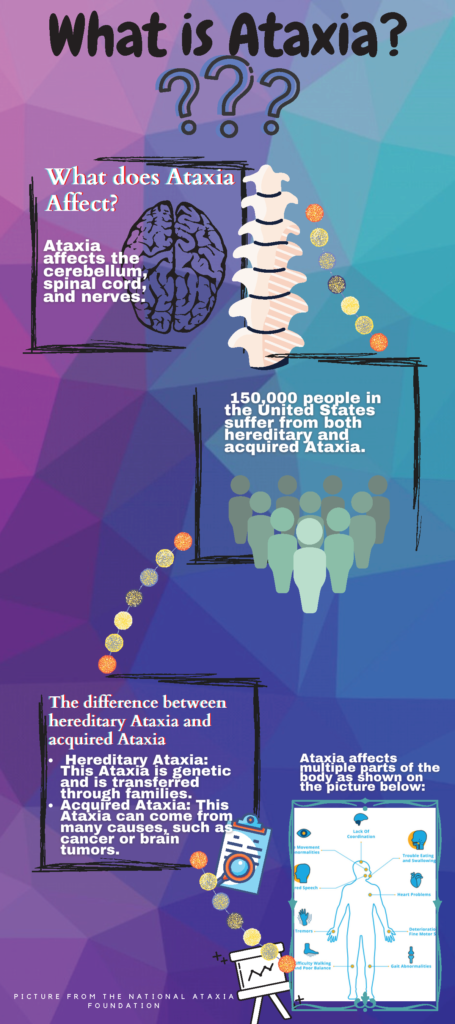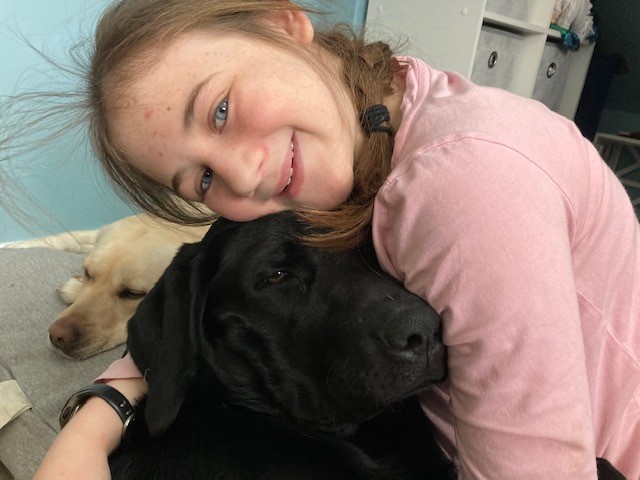Recently, a bright young lady reached out to NAF’s Research Services Director, Sue Hagen, to ask for help with her school project. She wanted to bring awareness to Ataxia and teach her classmates about the disease. Sue was happy to help. We were so impressed with her project that we asked if she would share it with the Ataxia community. We hope that she inspires other students to choose Ataxia for their school projects. Check out her essay and infographic below.
About Katie
Hi! My name is Katie Norton-Bower and I am a 7th grader in St. Paul, Minnesota. These are my two dogs in the picture above. The one I am holding is a Can Do Canines assistance dog in training, the one in the background is a career changed Can Do Canines assistance dog.
I first learned about Ataxia when I was young since my dad is a genetic counselor and I used to go to Ataxia fundraising walks. There I met some really nice people that I wanted to help so I decided to raise awareness about Ataxia and its research through my essay. I also met and interviewed Sue Hagen, who is the Director of Research Services for The National Ataxia Foundation, and was inspired by her passion to help people and felt more empowered to do something meaningful.

Above: Katie’s infographic for her school project
Katie's Essay About Ataxia Research
Ataxia Research
Ataxia? This word is unfamiliar to most, however it is important to recognize that
diseases such as ataxia exist in the world. Ataxia is a neurologic disease that affects the cerebellum of the brain, which controls your coordinated voluntary movement. It is both socially isolating and physically degrading since the symptoms include difficulty with speech and walking.
That is why we need to take action by funding research, so that we can aid the future
generations of patients with ataxia to help them lead better lives. We need to make funding research for ataxia as important as providing patient care for today’s ataxia patients and as important as funding research into other, more common, neurologic diseases. In addition, we need to raise awareness of this damaging disease broadly in our community.
I will be using quotes from an interview with the Director of Research for The National
Ataxia Foundation, Sue Hagen. She helped me see further into the importance of this research, and inspired me to take action and raise awareness.
Patient Care vs. Research
One of the most important arguments when discussing how to best help patients is
should we fund patient care or research? To put in perspective, patient care can help the wellness of life in the present, however research may help develop a cure which can help later generations have a higher quality of life. In the end it comes to a question of now or later.
Patient care includes therapy and focuses more on the present. Even though that
sounds like a better solution than research, it will not keep the disease indefinitely at bay. And if we can find a cure one day, we can maybe save generations of humans from having to suffer.
Sue Hagen agreed that there needs to be money to help people with ataxia get support,
such as getting wheelchairs and remodeling bathrooms. However, there also needs to be funding for research into new treatments and cures. “There are a lot of organizations that will help people with disabilities” she said, “But only the National Ataxia Foundation and the NIH fund ataxia research for all types of ataxia.”
Funding Over Other Diseases
Another important question is why fund ataxia rather than other neurologic diseases?
Ataxia is rarer than other neurologic diseases such as Parkinson’s disease and Alzheimer’s disease. Some would argue that it would be better to focus research on more common diseases. Unlike most common neurologic diseases ataxia can be found in any stage of life, from very early childhood to late adulthood. Because ataxia can impact very young children and young adults, it is important to search for a cure.
Sue Hagen explained that if we fund ataxia research for a cure, it will make it easier to
find cures for other neurologic diseases. This would be possible since all of these diseases affect the brain. “What we learn about this rare disease will translate to some of the more common movement disorders.”
Funding in General
Why should we fund this research in general? This question is raised since ataxia and many other neurologic diseases are rare compared to more common diseases such as cancer. However 150,000 people in the United States suffer from ataxia, a disease with no treatment or cure, at least not yet. So even though it is rare, it affects a large number of people.
Sue Hagen explained that families that have had loved ones that suffered from this
disease will usually donate specifically to ataxia research and she does not need to convince them. “I tell them that we will spend their money in the best way we can,” said Hagen.
Not all donors have a direct family member with ataxia. Last year there was a donor who gave the organization 400,000 dollars. They were not linked to ataxia through their family, but had a friend with the disease. This is a great act of compassion and shows that even if ataxia does not directly affect us, it does affect others and we can help so many people with a small donation.
Conclusion
Now ataxia research is becoming a global effort as the two largest research organizations have joined efforts. It is a bright sign for the future of ataxia research. No one should have to suffer from the disease and hopefully one day that will be the case.
In conclusion, funding ataxia research should be as important as funding patient care and funding research into other neurologic diseases. Even a small donation of time or money will make a big long term impact. Donating money is not the only option. We can also raise awareness in our communities to help push the fight against ataxia even further. If you know somebody with ataxia, you can help to share their story. If you don’t know somebody with ataxia, you could take the time to listen to their story.
As the development director at the National Ataxia Foundation once said, “Money buys research, research finds answers.”
Works Cited:
1. “What Is Ataxia.” National Ataxia Foundation , National Ataxia Foundation, 22 Jan. 2021, www.ataxia.org/.
2. Bushara K and Bower, M. “About ataxia.” Ataxia Center, University of Minnesota , University of Minnesota, 1 Jan. 2015, www.ataxiacenter.umn.edu/.
3. Hagen, Sue. Interview. By Katie Norton-Bower. 13 January 2021.
















